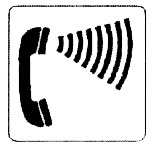Hearing Aid Compatible and Volume Control Telephones [4.13.5] [sic]
ADAAG requires that wheelchair accessible public phones, including pay and closed circuit phones, provide a volume control and be hearing aid compatible. In addition, 25% of all other public phones are required to have a volume control. Phones with volume control must be dispersed among all public-use phones, including closed circuit phones, throughout the facility.
Phones made in or imported into the U.S. are compatible with hearing aids as a result of the Hearing Aid Compatibility Act of 1988. A compatible phone generates a magnetic field that can be "translated" by hearing aids with a "T" switch, which activates a telecoil. This normally results in a clearer signal than having the hearing aid re-amplify the audible output of the handset. It is important that compatible phones be shielded or located away from other electromagnetic sources, which can interfere with the T-switch transmission.

ETA Editor's Note
This section was labeled 4.13.5 in the original document, but should have been 4.31.5.

User Comments/Questions
Add Comment/Question